Evaluation of the Impact of Bail Reforms on Summary Justice Reform
This report presents the findings from the Evaluation of the Impact of Bail Reforms on Summary Justice Reform. The research formed part of a wider package of work to evaluate Summary Justice Reform (SJR) in Scotland as a whole. The aim of the research was to evaluate how far the reforms to bail had met both their specific policy objectives as well as how far they had contributed to the overarching aims and objectives of SJR.
3 COMPLIANCE WITH BAIL
3.1 One of the specific policy objectives of the reforms to bail was to reduce instances of breach of bail conditions from pre-reform levels. Within that, the evaluation focused on reduced instances of failure to appear (in summary cases only) as it was considered that this was most relevant to the SJR objective of effective court hearings, as well as to reduce inconvenience to all those who attend court (including victims and witnesses) where cases are adjourned due to failure to appear by the accused. Data to explore if this has been achieved is presented in this chapter.
Breach of Bail by FTA and Breach of Conditions
3.2 The main source of statistical information showing the extent to which bail is breached by accused is data in relation to convictions for breach of bail. This national data relates only to breach by way of failure to appear and failure to comply with conditions, since offending whilst on bail is treated as an aggravator to the original offence, as described in Chapter 1.
3.3 Failure to appear will always be recorded and so this may appear to be a more significant factor determining convictions for breach compared to failure to meet conditions, simply due to data capture limitations. For the purposes of this report convictions for breaching bail is taken as the best proxy for actual breach.
3.4 Figure 3.1 shows the numbers of convictions for breach of bail in each of the case study areas and nationally for the nine year period from 2002/03 to 2010/11 with data again taken from the Criminal Proceedings publication10.
Figure 3.1 Number of Convictions for Breach of Bail by LCJB Case Study Area and Nationally
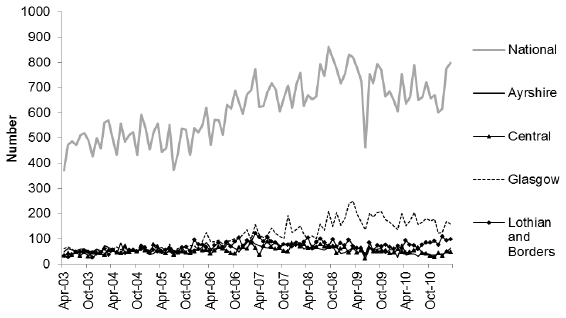
3.5 At the national level, there has been a slight upward trend in the number of convictions for breach of bail over time.
3.6 In Ayrshire, Central and Lothian and Borders the numbers of convictions for breach of bail (including failure to appear) have remained fairly steady over time with just some small peaks at random points in time, most notably in Lothian and Borders towards the end of 2010 and the beginning of 2011.
3.7 There is a slight upward trend over time in Glasgow and Strathkelvin, and, although the number of breaches is consistently higher, this area also has the highest number of bail orders imposed, on the basis that it deals with around 23% of all summary business in the country. Patterns in Glasgow and Strathkelvin match closely those at the national level most probably because these areas grant the highest numbers of bail orders and so actually drive the national trend.
3.8 Table 3.1 shows the number of bail breaches due to failure to appear separately from breach due to other reasons (i.e. non FTA breach or re-offending). Again, data covers both solemn and summary cases. It shows that, while non-FTA breach has increased quite notably over time, there has been a decrease in failure to appear. This downward trend was already evidenced pre-reform and, despite a peak in FTA during 2008/09, FTA has been decreasing again in recent years.
Table 3.1 Number of Convictions for Breach of Bail Nationally
| 01/02 | 02/03 | 03/04 | 04/05 | 05/06 | 06/07 | 07/08 | 08/09 | 09/10 | 10/11 | |
|---|---|---|---|---|---|---|---|---|---|---|
| FTA | 4,092 | 3,577 | 3,367 | 2,786 | 2,250 | 2,317 | 2,167 | 3,083 | 2,708 | 2,526 |
| Other Breach | 1,353 | 1,957 | 2,473 | 3,316 | 3,746 | 5,121 | 5,858 | 6,015 | 5,655 | 5,715 |
| Total | 5,445 | 5,534 | 5,840 | 6,102 | 5,996 | 7,438 | 8,025 | 9,098 | 8,363 | 8,241 |
3.9 The upward trend in national bail breaches when set against the downward trend in the total number of bail orders imposed suggests a higher proportion of bail breaches over time, although differences in the way that data are captured means that we cannot say conclusively if this is the case. What we can say, however, is that the overall bail reform objective of reducing the extent to which bail is breached by the accused does not appear to have been met, since there have been increases in the number of bail breaches post-reform, especially when removing FTA from the analysis. Some of this rise in breach rates may be a reflection of the police and courts treating breach more seriously post-reform and, as a result, more people being arrested and charged with the offence. The increase here would therefore reflect an increase in reinforcement and punishment activity among criminal justice professionals (i.e. a change in justice system practice) rather than reflecting a change in behaviour of accused (i.e. a greater propensity to breach).
3.10 Overall, there were 8,241 other bail-related offences in 2010-11 (other than committing an offence while on bail, which is discussed below). This includes breach of bail conditions, such as failure to appear in court after being granted bail. As a percentage of bail orders granted, this is around 18% or one in five of all orders granted.
Warrants for Failure to Appear
3.11 A specific focus of the research evaluation was to assess specifically how, if at all, failure to appear in summary cases had changed since the implementation of the reforms.
3.12 Indicator data is available for failure to appear where the accused was on bail at three stages in the court process, these being intermediate, trial and sentencing diets. Data for each of these indicators is shown for each of the case study areas in Figures 3.2 to 3.4 below. Again, it is worth stressing that data is not available for the period immediately prior to the reforms and so it is not possible to say anything about any immediate impact of the reforms on failure to appear, but the data does show the level of failure to appear over time since the reforms' implementation.
Figure 3.2 Failure to Appear at Intermediate Diet by LCJB Case Study Area and Nationally
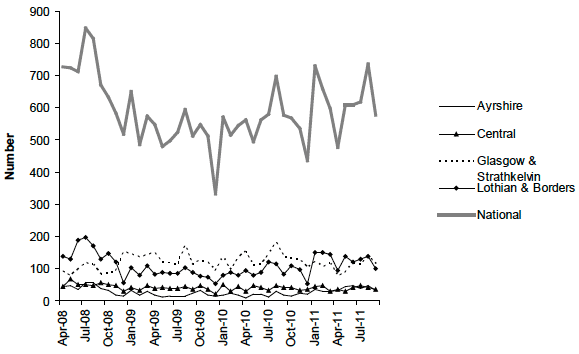
3.13 The intermediate diet is the stage in proceedings that follows the original appearance in court by the accused when they will have been granted bail, at which defence and prosecution are required to indicate whether they are ready to proceed to trial. The data above shows that there was a drop in the number of persons failing to appear at this court diet from the time at which records began (i.e April 2008), and this continued for an 18-month period before rising again throughout 2010/11.
Figure 3.3 Failure to Appear at Trial Diet by LCJB Case Study Area and Nationally
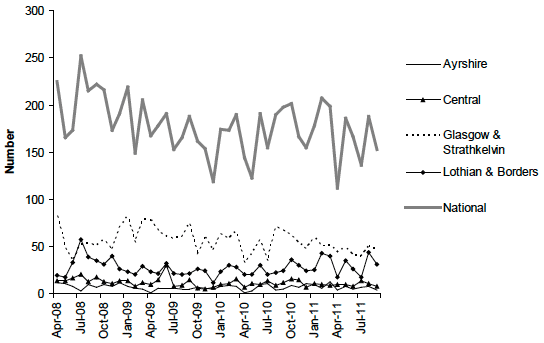
3.14 If evidence is to be led, the trial diet is the stage at which this will take place and is, therefore, the stage in proceedings where failure to appear by the accused will cause the most disruption. This is because witnesses are likely to have been cited to attend at the diet, and may be asked to return at a later date if the case is adjourned due to failure to appear by the accused.
3.15 Again, the data show that there has been a clear drop in the numbers of people failing to appear at this diet since the reforms were implemented, although there do remain some peaks and troughs in the data at different points in time.
Figure 3.4 Failure to Appear at Sentencing Diet by LCJB Case Study Area and Nationally
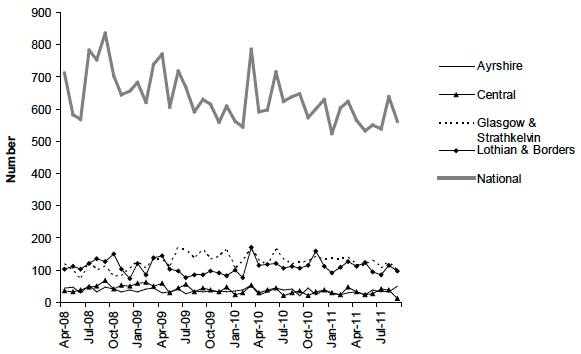
3.16 The sentencing diet is the stage in proceedings when the final disposal is decided. FTA at this stage of proceedings is, in particular, unwelcome for victims for whom knowing sentencing outcomes seems to be a key driver of satisfaction with the system (see the separate evaluation of Victims, Witnesses and Public Perceptions). Delaying sentencing decisions by failing to appear may lead to negative perceptions of the system by victims who are seeking early case closure, as well as being an inconvenience and waste of court time and resources for prosecution, defence and court staff. Data show that, as with the intermediate and trial diet, there has been a drop in the numbers of people failing to appear at this diet and this again bodes well for the aims of SJR.
3.17 It may be that reduced instances of FTA are linked to the general downward trend in cases coming to court (although this same argument cannot be applied to breach rates overall, since they have increased). If there has been a proportional drop in FTA, it may be argued that this, in part, is contributing to the wider SJR objective of more effective court hearings. That said, from the data available, it is not possible to say if this can be directly attributed to the reforms to bail.
3.18 The following section provides a broader context for the reduction in FTA in terms of convictions and penalties given for failures to appear.
Penalties for Breach of Bail
3.19 Figure 3.5 shows the number and type of penalties given for failure to appear at the national level for all courts.
Figure 3.5 Main penalty for breach of bail for failure to appear
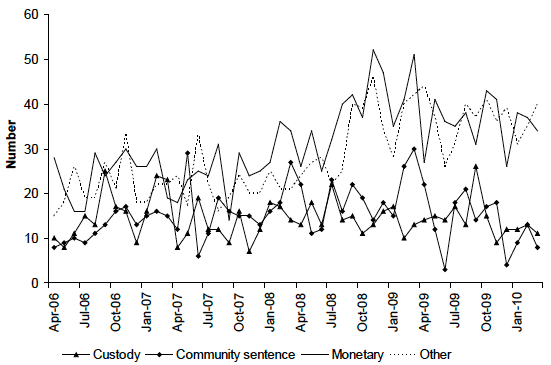
3.20 The data show that most failures to appear are dealt with by way of a monetary penalty (i.e. a fine) with fewer attracting community or custodial sentences. 'Other' penalties include compensation orders, although their use is rare in these circumstances. Although the number of custodial and community sentences has remained fairly steady post-reform, with only a slight recent lowering of numbers, there has been quite a noticeable increase in the numbers of FTAs dealt with by way of monetary and other penalties (though overall numbers are still low).
3.21 Data is also available that shows the average value of penalty imposed for breach of bail by way of failure to appear. The average penalties by type for the five year period from 2003/04 to 2009/10 is shown in Table 3.2 below.
Table 3.2 Average value of penalties imposed for breach of bail by way of Failure to Appear11
| 03/04 | 04/05 | 05/06 | 06/07 | 07/08 | 08/09 | 09/10 | |
|---|---|---|---|---|---|---|---|
| Custodial Sentence (days) | 62 | 68 | 75 | 56 | 106 | 79 | 75 |
| Community Service Order (hours) | 116 | 136 | 140 | 143 | 125 | 135 | 127 |
| Fine (£s) | 120 | 132 | 163 | 139 | 175 | 154 | 150 |
3.22 The data show that the average custodial sentence given for failure to appear on bail doubled between 2006/07 and 2007/08, the time during which the reforms came into place. Thereafter, the average dropped to levels similar to those pre-reform, although was still slightly greater. There have been no great changes in the average values for all other penalties.
3.23 Figure 3.6 shows the main penalties given for bail offences, other than failure to appear or re-offending. It shows that breach of other bail conditions are dealt with in a variety of ways with no obvious patterns in terms of the most frequently used penalty over time, except for an overall increase in each.
Figure 3.6 Main penalty for offences other than FTA or re-offending
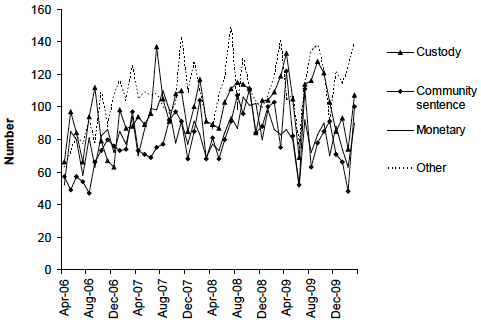
3.24 Again, data are also available for the average penalties imposed for these breaches and Table 3.3 below shows the average penalties by type for the five year period from 2003/04 to 2009/10.
Table 3.3 Average value of penalties imposed for breach of bail other than for Failure to Appear or Re-offending12
| 03/04 | 04/05 | 05/06 | 06/07 | 07/08 | 08/09 | 09/10 | |
|---|---|---|---|---|---|---|---|
| Custodial Sentence (days) | 64 | 66 | 65 | 63 | 64 | 77 | 80 |
| Community Service Order (hours) | 132 | 125 | 120 | 112 | 121 | 120 | 117 |
| Fine (£s) | 182 | 183 | 176 | 164 | 181 | 174 | 170 |
3.25 The data show that the average custodial sentence has increased post-reform, although the average values for all other penalties have remained largely unchanged. This shows that longer average custodial sentences are being given for breach of bail post-reform - this is consistent with the increased penalties introduced by the reforms.
Aggravated Bail
3.26 As described in Chapter 1, where a person on bail commits a further offence whilst on bail, it is regarded as bail aggravation and is not prosecuted as a separate offence. Instead, the original sentence can be supplemented and enhanced penalties imposed for that offence.
3.27 Table 3.4 below shows the number of offences with a charge proved with a bail aggravator recorded for the period 2004/05 to 2010/11 for all courts13. It shows that, consistently, fewer than 1 in 5 offences have a bail aggravator attached and, although the percentage of cases with bail aggravators increased to a small degree in 2007/08 and 2008/09, it has since reduced again.
Table 3.4 Convictions for offences with a Bail Aggravator recorded, 2004/05 to 2010/11
| 04/05 | 05/06 | 06/07 | 07/08 | 08/09 | 09/10 | 10/11 | |
|---|---|---|---|---|---|---|---|
| Bail Aggravator Recorded | 25,543 | 25,799 | 29,026 | 30,592 | 32,618 | 24,326 | 24,017 |
| All Offences | 188,182 | 182,377 | 188,585 | 185,131 | 174,505 | 163,456 | 154,023 |
| Percentage of Offences with a Bail Aggravator | 14% | 14% | 15% | 17% | 19% | 15% | 16% |
Perceptions of Breach of Bail and Sentencing for Breach
3.28 As part of the stakeholder interviews, staff were asked to comment on whether they perceived there had been any impact of the reforms to bail on breaches of bail. Participants were also asked whether they perceived that there had been an increase in the length of sentences or other disposals used for breach of bail.
Breach of Bail
3.29 The police who were interviewed generally perceived that there had been no real decrease in the numbers of bail breaches that they were witnessing. Despite generally viewing bail conditions as tougher post-reform, the police uniformly asserted that some offenders were recidivist offenders who were 'in and out jail all their lives' and would take 'no notice' of bail conditions. This was used as an explanation for breach:
"Most of these are recidivist offenders, the fact that they are under bail conditions doesn't really make any difference to them, they just see it as a hazard of their existence that they get caught now and again. Then they get out on bail and then it's back to square one." [Police]
3.30 Some police officers considered that breach rates, especially failure to appear, may have increased in recent years. While the numeric data does support an overall increase in breach, this does not, appear, however, to be accounted for by failure to appear. FTA in isolation reduced slightly in numbers, though whether it has reduced proportionately is less clear.
3.31 A common assertion from the police was that bail (and special conditions) may be being used too widely. A view was put forward that, "because everyone receives bail", it "makes a mockery of the system", especially if a person has two or more bail orders and receives yet another, when they have already evidenced an inability to adhere to their conditions:
"In the custody suite, I see people who have 2 or 3 bails on their records, so perhaps the special conditions they have been given are not appropriate as they are breaching them." [Police]
3.32 Again, these views differed from the numeric data which actually show a drop in the number of bail orders awarded and so the main issue, perhaps, is that police were perceiving too great a use of bail orders for persons who had already received a bail order. Indeed, the data does show that around 1 in 4 of all accused given bail have received two or more orders in one year and this has been fairly consistent over time, as discussed in Chapter 2.
3.33 Among some Sheriffs and JPs, there was also some perception that breach of bail was increasing over time. This was in part attributed to the overzealous use of bail and special conditions in some cases for what were perceived to be less serious offences:
"That's the downside of bail. It's a double or quits. It's an exponential game and people can end up in a detention sentence, really for doing nothing….you can end up criminalising people, and ramping up the punishments for the kernel. And really, the criminal kernel is not really that serious". [Sheriff]
"I think there have been an awful lot more insignificant bail cases and breaches of bail". [Sheriff]
3.34 Some Sheriffs reported being very careful in their use of special bail conditions, and there was a keen awareness among some interviewees that being overzealous with bail conditions may result in more people returning to court because they were unable to comply.
3.35 Curfews, in particular, were seen as being challenging for some lower tariff offenders and some members of the judiciary explained that the use of curfews as a bail condition seemed to inappropriately curtail people with already chaotic lifestyles. Consequently, some members of the judiciary expressed that they were reserving curfews for higher risk (especially public risk) offenders.
3.36 Similarly, some defence agents and Procurators Fiscal considered that breach rates had not fallen, in line with the quantitative data. It was perceived that this was especially true for cases where curfews were attached. One defence agent stated:
"I think what happens is that it brings a lot more cases into court because most of the conditions are ones that everyone knows they will breach". [Defence Agent]
3.37 One of the areas that the judiciary and defence agents both commented on as being problematic with regard to bail conditions was domestic abuse cases. While both acknowledged that the intention of special bail conditions to protect victims in domestic abuse cases was well founded, it was suggested that sometimes victims failed to support the special conditions and this may be resulting in some breaches of bail:
"…and what we get also is the complainer contacting us, the defence lawyer, saying that they want them [their partner and accused] back, and we put in an appeal letter and the Crown comes back and says "It's not your decision". [Defence Agent]
3.38 Overall, therefore, professionals expressed that breach of bail may not have improved over time and this was attributed largely to failure among accused to comply with special conditions. In some cases, this failure was due to lack of willingness to comply, whereas in others, it was perceived as being due to offenders finding conditions too challenging to comply with. There was some appetite for releasing some accused without special conditions in order to remove this, although these views were expressed by a minority of interviewees and, overall, it was recognised that bail conditions provided a useful public protection tool that was less costly than the alternative of remand. The overriding message appears to be that special conditions need to be carefully considered and be relevant to the specific case.
Sentencing for Breach
3.39 Although some Sheriffs and JPs stated that they were reluctant to impose bail conditions without good reason (and perceived that some colleagues were using them perhaps too widely), where conditions were breached, there seemed to be consensus around the need to award longer sentences to act as a deterrent to future breach and offending:
"Yes, I am using the increased sentencing powers and I think it's a nonsense if you don't send out the message. I think I do award harsher sentences for breach of bail in general and I also think you have to make it consistent, which I always do". [Sheriff]
"I think when you are reading out the specific punishment for breach of it...…the fine or the imprisonment or both…..that registers, particularly when you add the fact that this would be in addition to whatever they were sentenced to, if found guilty of the original offence that this was a totally separate punishment and related to breach in bail only, I think once that message gets into their head it makes them do pay attention". [JP]
"I am taking breach of bail into account now when we are passing a sentence which we maybe didn't do in the past". [JP]
3.40 Generally, Procurators Fiscal and defence agents were also of the view that stronger repercussions were being applied to breach of bail orders and conditions, both perceiving that the remanding of an accused was being used more often for breach of bail post-reform:
"Where I find the Sheriffs much harder is that when people are breaching bail, they are generally remanding them in custody instead of just letting them out, so that's a change". [Defence Agent]
3.41 In this respect, the qualitative and quantitative data were mutually supportive around increased sentencing being used for breach of bail post-reform.
Summary
3.42 Overall, both the quantitative and qualitative data suggest that there has been no reduction in the overall number of breaches in the period since the reforms were implemented - indeed, the opposite is true with an increase in bail breaches overall.
3.43 When looking at FTA, although there has been a numerical reduction, it is not possible to say if this drop has been proportional given reduced numbers of cases coming to court overall. If there has been a proportional drop in FTA, it may be argued that this, in part, is contributing to the wider SJR objective of more effective court hearings. That said, from the data available, it is not possible to say if this can be directly attributed to the reforms to bail.
3.44 The quantitative and qualitative data both show that breach of bail is being treated more seriously post-reform with increased custodial sentences being applied, and an attitude of non-tolerance of repeat breaches of bail among the judiciary.
Contact
Email: Carole Wilson
There is a problem
Thanks for your feedback